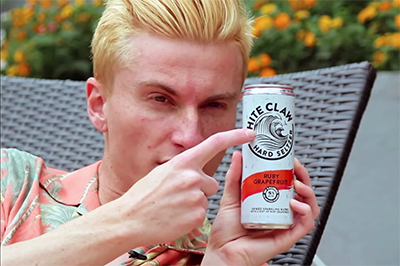Blog
Search
New Hard Seltzer and the Big Old Lie
 No beverage product has received more publicity over the past year than hard seltzers. These colorless carbonated alcoholic drinks often come with the same faint fruit flavors of La Criox. Hard seltzer brands such as White Claw, Bon & Viv, and Truly advertise their low calories, lack of gluten, and inclusion of fruit. It's nice to think that consumers, jaded on the repeated, deceptive, manipulative, and sometimes overtly corrupt efforts to connect alcohol to health, are immune to the "healthy drinking" scam. But hard seltzers are one of the most rapidly growing product groups in the industry. According to Vox.com, their current market share is estimated at $550 million, and at least one forecaster has that growing to as much as $2.5 billion by 2021.
No beverage product has received more publicity over the past year than hard seltzers. These colorless carbonated alcoholic drinks often come with the same faint fruit flavors of La Criox. Hard seltzer brands such as White Claw, Bon & Viv, and Truly advertise their low calories, lack of gluten, and inclusion of fruit. It's nice to think that consumers, jaded on the repeated, deceptive, manipulative, and sometimes overtly corrupt efforts to connect alcohol to health, are immune to the "healthy drinking" scam. But hard seltzers are one of the most rapidly growing product groups in the industry. According to Vox.com, their current market share is estimated at $550 million, and at least one forecaster has that growing to as much as $2.5 billion by 2021.The rise of hard seltzers are the dark side of a hopeful trend: younger generations may be less likely to use alcohol than their forerunners. It is unclear whether this decline comes from the economic hardships Milennials and "Gen Z" face, from the rise of legal cannabis, from effective prevention campaigns, or from shifting trends. What is clear is that Big Alcohol is concerned, and hard seltzers are what they hope to be the magic bullet. Speaking the Brewbound (subscription required), Molson Coors confirmed that their new hard seltzer, Vizzy, is targeted directly at the 21 to 34-year-old market. Ultimately, hard seltzers are just another incarnation of flavored malt beverages--cheap, easy-to-drink alcohol that carries significant appeal to novice drinkers, especially those underage.
Needless to say, the marketing surrounding hard seltzer is an overt, if well-worn, lie. Alcohol use alone carries health risks. Even low levels of drinking can leave a consumer vulnerable to cancers and certain cardiovascular diseases. As consumption rises, organ damage, accidental injury, motor vehicle crashes, violence, and self-harm become significant risks as well. Alcohol dehydrates, may slow muscle recovery, and interferes with metabolism--never mind the hangover (and potential for long-term mental decline). This is part of why this same lie needs to be constantly repackaged for new generations.
As the old lies recur, so do the old bad actors. FourLoko, a manufacturer notorious for selling products in such large containers and at such high concentration that a single can becomes the equivalent of binge drinking, has introduced its own line of 12% ABV seltzers in 22 oz. cans. This is the equivalent of 5 White Claws, which, at 5%, are already towards the higher end of canned alcohols. Multiple bars, meanwhile, use the seltzers as a base to build mix drinks.
And with bad actors come bad laws. In 2019, Big Alcohol successfully conned the California legislature into placing its products in the same tax class as beer, which is already the least taxed of all alcoholic products. This comes despite the fact that their production often bears more in common with hard liquors than Bud Light (and at 12%, FourLoko's product is stronger than many wines).
"These companies are making potentially high-potency, nearly flavorless alcoholic beverages, and paying back peanuts," said Michael Scippa, Public Affairs Director for Alcohol Justice. "We need tax rates to reflect the real harm. When you get around 6 or 7%, you're already selling more than single serving of alcohol, especially in big cans. We need to get rid of this loophole and get a Charge for Harm tax system in place, starting today."
Already, backlash is in place. Writing for Eater.com, Jaya Saxena points out that "positioning alcohol as a tool to build a better, cleaner body is just the flip side of positioning it as a cool potion necessary for any adult party—either narrative makes it harder to have a healthy relationship with it." The alcohol harm prevention world needs to be taking a long, hard look at these products, and speaking loud against the healthy drinking myth. Fighting the hype is the only healthy choice.
READ MORE about the exploitive myths of healthy drinking.
READ MORE about the alcohol industry's efforts to corrupt NIAAA.
READ MORE about Charge for Harm in California.
Help us hold Big Alcohol accountable for the harm its products cause.
| GET ACTION ALERTS AND eNEWS |
STAY CONNECTED    |
CONTACT US 24 Belvedere St. San Rafael, CA 94901 415-456-5692 |
SUPPORT US Terms of Service & Privacy Policy |
Copyright © 2025 Alcohol Justice. All Rights Reserved.
Joomla! is Free Software released under the GNU General Public License.


